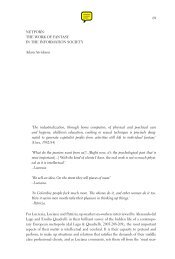Nakamura, Digitizing Race, Introduction, chapter 5, Epilogue
Nakamura, Digitizing Race, Introduction, chapter 5, Epilogue
Nakamura, Digitizing Race, Introduction, chapter 5, Epilogue
You also want an ePaper? Increase the reach of your titles
YUMPU automatically turns print PDFs into web optimized ePapers that Google loves.
18 <strong>Introduction</strong><br />
Racial formation theory has not often been used in reference to new media,<br />
however, partly because the frame of reference is so different (and because<br />
the early utopian bent to Internet criticism meant that discussions of difference,<br />
especially if viewed as “divisive,” were avoided). The difference between<br />
old and new media lies in the new media’s interactivity, as mentioned before,<br />
but is also related to the blurred line between producers and consumers.<br />
Though utopian claims regarding the Internet’s ability to abolish the position<br />
of the passive viewer, making everyone a potential publisher or creator<br />
of media, are less valid than previously thought (early predictions about<br />
everyone’s eventually having or even wanting a personal home page have<br />
fallen far short of reality, though the popularity of blogs, vlogs, and social<br />
networks such as Facebook and MySpace are coming closer to this ideal), it<br />
is possible now, since the massification of the Internet in the United States,<br />
which is my frame of reference, to view media on the Internet as the product<br />
of non–cultural elites.<br />
Since the turn of the century, the continuum of Internet access in the<br />
United States has gotten wider and broader—it is best compared to Rich’s<br />
lesbian continuum and Parks’s formulation of varying degrees of visual capital<br />
in the sense that everyone has some position in relation to it. Rather<br />
than a “digital divide” that definitively separates information haves from<br />
have-nots, the Internet has occasioned a wide range of access to digital visual<br />
capital, conditioned by factors such as skill and experience in using basic<br />
Internet functions such as “search” in addition to less-nuanced questions<br />
such as whether or not one possesses access at all. 29 While earlier racial formation<br />
theory assumed that viewers were subject to media depictions or<br />
racial projects that contributed to racialization, and that these projects were<br />
ongoing and differential but nonetheless worked in a more or less one-way<br />
fashion, new media can look to an increasingly vital digital cultural margin<br />
or counterculture for resistance.<br />
AIM buddies, pregnant avatars, and other user-created avatars allow<br />
users to participate in racial formation in direct and personal ways and to<br />
transmit these to large, potentially global audiences of users. Intersectional<br />
critical methods are vital here; digital visual culture critique needs to read<br />
both race and gender as part of mutually constitutive formations. For example,<br />
in the case of sports gaming, most celebrity avatars are men because of<br />
the dominance of men in the commercial sports industry, and many of them<br />
are black for the same reason. Yet black men are underrepresented as game<br />
designers, and it would be wrongheaded to mistake the plurality of racialized





